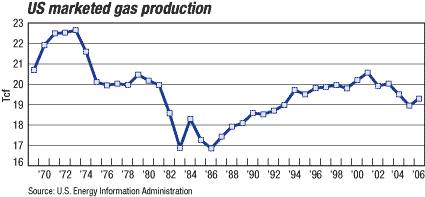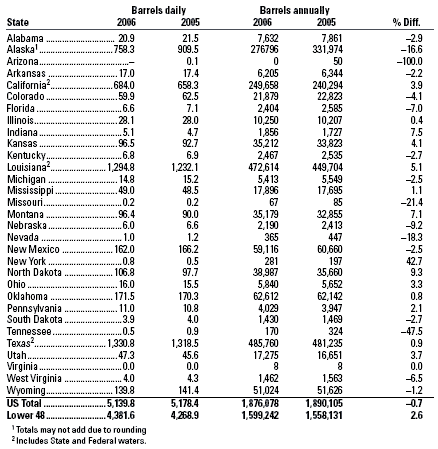OUTLOOK 2007: US PRODUCTION
Production is up, and it’s down, depending on how you measure it
Crude and condensate production for the US is slightly down, which is normal. But it is not for normal reasons. It could have been flat to slightly up, which, considering that US production usually declines, would be an impressive feat, and would no doubt be due to high oil prices.
However, the extraordinary hurricanes of 2005 hurt US production. The odd thing is that, by comparison, those events made 2006 production look like a significant gain of 2.6% had taken place in the Lower 48, including offshore areas. If the unusual offshore comparison is eliminated, Lower 48 production is still likely to be positive for 2006 over 2005, but only by about 1%.
Recall that, after a brief respite in 2003, Alaska had slipped back into its previous 6% to 10% decline mode, as expected. Then the North Slope pipeline leaks hit last year, making a bad decline situation worse. So, Alaskan production pulled the entire US down, despite the positive upside from robust Lower 48 land production and the positive year-to-year comparison in the Gulf.
It should be remembered that these production numbers are only estimates; they will be revised over the next two years, the amount of which is anybody's guess, since there were considerable adjustments in the Department of Energy data for 2006, both up and down. But the general picture will likely remain the same.
 |
US crude and condensate production by state (thousand barrels)
|
|
| US crude and condensate production by state (thousand barrels) |
 |
|
Natural gas. Revised data for 2005 show that gas production fell only slightly from 2004, down 4%. Last year, production was essentially flat with 2005, as the effects of 2005's hurricanes were still being repaired well into 2006. Gas in storage was 2,936 Bcf as this was being written in mid-January, which is 20.1% above the five-year average level for the same period. It will take more than a month of very cold weather to work inventory levels down to more typical amounts. The persistently high storage levels are making traders nervous, but so far are not causing prices to go down much.
These themes keep repeating: demand is flat, prices are high, and it takes a continuous, robust effort just to keep up, let alone, expand production. Unconventional shale gas plays are now spreading.While this helps with reserves additions, these wells have low deliverability, so it takes a lot of drilling just to stay even. 
|




